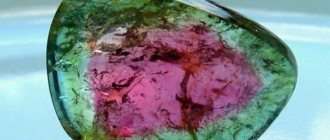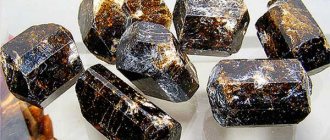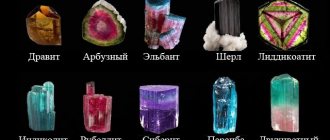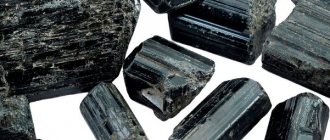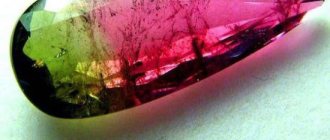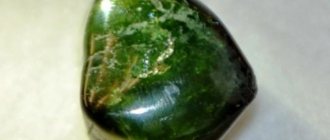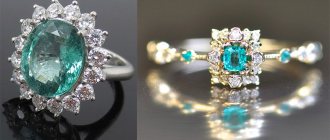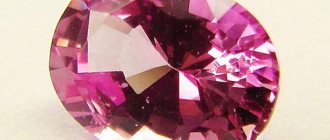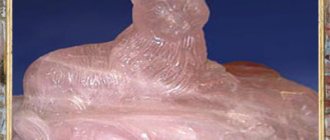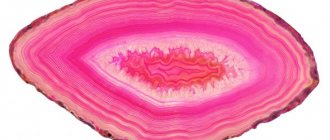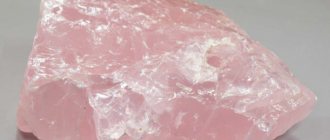/ List of stones / Properties of Pink Tourmaline
0
5517
Article rating
Rubellite or pink tourmaline is the stone of Venus and Cleopatra, which was first described by the Irish scientist Richard Kirwan in the second half of the eighteenth century. The name of the mineral comes from the Latin rubellus, which means reddish. This stone is otherwise called crimson schorl, apirite, daurite, sibirite. A separate variety of rubellite is elbaite, mined on the island of Elba and distinguished by its particular beauty.
Pink tourmaline
Shades of pink tourmaline can range from deep red to soft pink. In total, there are more than fifty color varieties of this mineral. The color saturation depends on the amount of manganese compounds in the stone. In appearance, rubellite is sometimes confused with rubies. Under this name it even found its way into imperial crowns. In fact, these two stones are easy to distinguish: in the light, a ray passing through a ruby will be red, and through a rubellite it will split into two different shades. Transparent stones are classified as precious stones. Opaque - are considered ornamental and are used in interior design, making small figurines and costume jewelry.
History and origin
Tourmalines are a large family of gems that vary in color but have similar properties.
By nature, these are aluminum borosilicates with a very complex formula. The composition of rubellite additionally includes sodium and divalent manganese, which provides reddish-pink shades. Other colors of tourmalines contain iron, lithium, potassium, calcium, chromium, magnesium and fluorine.
Pink tourmaline gemstone
Pink tourmaline had an unusual fate. It became known in Europe and Russia around the end of the 14th century, reaching the West in a roundabout way from Asia. They knew about tourmaline in ancient Greece and Rome, but they could not distinguish it from other stones of similar color - rubellite from ruby, verdelite from emerald, indigolite from sapphire. Even many rubies in the personal jewelry and crowns of the kings of the Czech Republic and the kings of Rus', after testing in the 18th–19th centuries, when science had reached a sufficient level, turned out to be tourmalines.
Among the treasures of the Russian Empress Catherine the Great is a magnificent 255-carat bunch of grapes carved from a red gem.
The Swedish king Gustav III, who gave her this bunch, claimed that it was made of ruby and in ancient times belonged to Julius Caesar himself. In fact, it is made of rubellite.
The study of tourmalines as independent stones began in 1704, when the Dutch brought pink and bicolor red-green crystals from their colony, the island of Ceylon, which were called “turmalli” in Sinhalese (one of the Ceylonese languages). This literally means “precious stone”.
Pink tourmaline pendant
For 90 years, the stone was studied by various scientists, and in 1794, the Irishman Richard Kirwan finally established that it was a completely independent mineral. He also described the physical properties of the stone.
Now rubellite belongs to the second order of the first group of precious stones of jewelry value (according to the Fersman-Bauer classification). It is valued on the same level as noble opal, topaz, aquamarine, uvarovite and zircon and is only slightly inferior in price to sapphire, ruby and emerald. A gold piece with a red or pink tourmaline crystal, depending on the weight of the stone and the gold, can cost several thousand dollars.
Opaque tourmaline is used as an ornamental stone. In Rus', raspberry sherl, like any other pink stone, was called lal or lalik.
Rubellite stone is used not only in the jewelry industry. It is used in radio engineering and some contact healing products of alternative medicine, such as health lumbar belts, knee pads and mattresses, since it is believed that these stones are capable of ionizing the air.
Color and shape of tourmaline
A striking feature of tourmaline is that uniformly colored crystals are almost never found in nature. Red, pink, yellow, blue, green and purple - all tourmalines are multi-colored! Moreover, all crystals are quite transparent.
Due to its stunning variety of colors, tourmaline is often confused with a wide variety of stones. Sometimes it looks like an amethyst, sometimes like an emerald or even a ruby. There are tourmalines similar to chrysoberyls and chrysolites, citrines and zircons.
In terms of variety of colors, tourmaline surpasses many other precious stones that are distinguished by a rich color palette, even corundum! Thanks to this property, tourmaline is highly valued by jewelers.
The stone delights buyers! But tourmaline has one feature - it is a relatively soft material, so rings with gems are rare. Most often, the stone is used in the manufacture of earrings, necklaces, and brooches.
Tourmalines are cut, like all colored stones, with a brilliant cut on top and a step cut on the bottom. The crystals from which earrings are made are most often given a teardrop shape. Tourmalines, which have a fibrous structure, are cut into cabochon shapes, which gives them a “cat’s eye” effect.
The color of tourmaline crystals is so juicy and beautiful that you just want to eat them! All shades are simply unusually “tasty”, full of fruit and berry freshness. It is not for nothing that a popular variety of the mineral is called watermelon tourmalines - these are crystals of a traditional pink-white-green color, thanks to which the gem really resembles a piece of juicy watermelon! Such a crystal has a bright red core, a white zone is located on top of it, and a green layer on top - “watermelon rind”.
The most beautiful and most famous tourmaline in history has a very funny name - “Jolly Green Giant”. This beautiful tourmaline is kept in the New York State Museum of Natural History.
Another famous tourmaline was discovered in the crown of the dynasty of Czech kings. When the examination was carried out, it turned out that the largest red ruby was not a ruby at all, but the most tourmaline!
The famous Bunch of Grapes was created from the royally luxurious red tourmaline, which was presented to Empress Catherine II by the Swedish king himself.
Such a fantastically diverse palette is ensured by the very complex composition of the mineral. Jewelry tourmalines contain alkali metals, which provide variegated and romantic coloring. The presence of lithium gives birth to the most valuable pink tourmaline, magnesium turns the gem into a beautiful brown crystal. Iron colors the structure of tourmaline black.
Individual parts of a tourmaline crystal almost always have a different color from each other, often highly contrasting, with sharp boundaries. Such parts are usually separated by planes. The color zones have beautiful cylindrical shapes.
Physicochemical characteristics
The physicochemical characteristics of this stone are unique. It has a hardness of up to 7.5 Mohs, a fairly high density, but is also fragile. The degree of transparency varies; Rubellite stone can be transparent or opaque.
Polychrome specimens of tourmaline are quite common.
Part of the stone is painted green, part - pink. Specimens with a red center and green edges are mined, or vice versa - with a green center and a red-pink perimeter.
Transparent pink tourmaline has the same properties as its other counterparts:
- pleochroism - the ability to change color from pink to yellowish depending on the lighting;
- birefringence - a ray passing through a crystal is split into two;
- slight dispersion.
But pink tourmaline, unlike red, does not have luminescence. That is, it does not glow in the dark.
This gem has the ability to become electrified by friction, heat or pressure, with one end of the crystal accumulating a positive charge and the other a negative one.
| Formula | height 2 cm Formula Na(Li,Al)3Al6[(OH)4|(BO3)3Si6O18] |
| Color | Pink |
| Shine | Glass |
| Transparency | Transparent to opaque |
| Hardness | 7—7,5 |
| Cleavage | Unclear |
| Kink | Uneven, small-shelled; fragile |
| Density | 3.02—3.26 g/cm³ |
Varieties
Red or pink – rubellite. The most expensive option for minerals of this type.
Blue – indigolite. It is naturally dark in color. However, it is often heated to make the stone lighter. This makes him attractive.
Brown is drastic. Also often lightened.
Colorless - archroite. It is extremely rare in nature. It is obtained artificially by heating the pink mineral.
Watermelon tourmaline is pink in the center and green on the edges. Sometimes the reverse distribution of colors occurs. The photo of the unprocessed version of this mineral is not impressive, but in its processed form the stone looks very appetizing.
Black – sherl. The most common option.
Yellow and yellow-green. Does not have a separate name.
Green – verdelite. Very similar to emerald, with which it is often confused.
As with the magical properties of aventurine, the effects of stones of different colors vary greatly. The most pronounced metaphysical meanings are those of pink, red, green, blue and black tourmalines.
Mining locations
Tourmaline deposits are located in different regions of the globe. The pink variety is mined on the island of Elba (these stones are called elbaites), in Sri Lanka (formerly Ceylon), in Brazil - the states of Bahia and Minas Gerais, in the USA - the state of California. In Russia, it is found in Transbaikalia (Malkhan deposit) and on the Kola Peninsula, in the Voronya tundra area.
Pink tourmaline beads
But in our country, deposits of pure pink tourmaline are rare; it is mostly found together with green.
Rubellite often accompanies zircon, corundum, hematite and spinel in rocks.
Medicinal properties
The healing and magical properties of tourmaline depend on its color.
Lithotherapists, together with esotericists, believe that pink tourmaline affects the heart and sacral chakras. Its “area of responsibility” includes the heart, along with the entire cardiovascular system, the terminal part of the intestine, as well as the thoracic, sacral and coccygeal sections of the spine.
Jewelry with pink tourmaline is useful to wear for people suffering from cardiovascular diseases - hypo- or hypertension, coronary disease, including those who have had a heart attack.
The precious gem promotes active saturation of the blood with oxygen, which improves the general condition of the body and stimulates thought processes. It is suitable for those who suffer from problems with the musculoskeletal system, pain in the thoracic and sacral spine, for example, with hernias. For this purpose, there are special mattresses and corsets in which tourmaline crystals are arranged in an optimal manner for treatment.
Rubellite treats diseases of the rectum, such as hemorrhoids, as well as prostatitis in men.
Emotionally, pink tourmaline has a liberating effect.
It relieves a person from unnecessary complexes and embarrassment, helps to openly express his feelings, including in the intimate sphere.
Ring with pink tourmaline
This stone has projective yang energy, that is, it is a specific “male” mineral.
For representatives of the fair sex, tourmaline will add sexuality and self-confidence, but they should wear it with caution - it can lead natural passion to nymphomania and sexual intemperance.
This stone “loves” naturally strong natures, emotional and bright, but at the same time strong-willed and self-confident. But it is better for the lazy and weak-willed to avoid it - rubellite will give them a thirst for activity, but will not be able to overcome their natural laziness. As a result, a person can easily develop a neurotic or psychotic illness.
Favorite of Emperors
Since ancient times, rubellite has enjoyed special love among those in power. It started with the famous Caesar Ruby. Later, pink and scarlet crystals adorned the crowns of Empresses Catherine I, Anna Ioannovna, and Russian Tsars Ivan Alekseevich and Mikhail Romanov.
The church tried to keep up. You can see the monstrance in the Kremlin Armory. It is decorated with pink rubellite weighing 645 carats.
The Legend of Caesar's Ruby
A legend because there is no official confirmation, but the history of the stone is beautiful and worth knowing.
The most famous rubellite in history is... ruby. Not just any ruby, but a Caesar Ruby. It has a long, often confusing, not always documented history.
It is traditionally believed that the huge (weighing more than 250 carats) gem was presented by Cleopatra (Queen of Egypt) to Caesar, her lover. True, there love affairs are mixed up with economics and politics, but that’s not what we’re talking about. Why ruby - the name rubellite arose much later. In those ancient times, red crystals were called rubies; they did not fool themselves with gemology.
Years passed, and on the ruins of the Western Roman Empire, the Frankish Empire arose, led by Charlemagne. It was he who inherited Caesar's Ruby, which was inherited by his son Louis the Pious, and was further passed on through the royal family.
Nobody probably knows how the gem got to the Templars. Maybe the king gave it as a gift, or maybe he paid it for debts... The Templars were the richest knightly and monastic order, and often lent money to kings (as a rule, they were always in need of money).
King Philip the Fair decided that everything was better than a little and on credit. Therefore, the Templars, led by the Supreme Master, burned some alive, some were carved on the wheel, some were mercifully beheaded (they weren’t even tortured).
The treasures of the Templars went to the royal treasury. And again there is a gap in the history of stone.
How the stone got to the Jesuits, instead of remaining in the royal treasury, is unclear.
The legend ends with the fact that the Jesuits gave the gem to Charles IX after the Night of St. Bartholomew. This is where the story begins. It is confirmed by documents, there is no doubt about it.
We recommend: WATERMELON TOURMALINE - the delicious beauty of a gem
The history of the most famous rubellite
After the death of Charles IX, the gem had to travel. The gem passed from hand to hand, from country to country.
List of stone owners:
- Elizabeth of Austria, widow of Charles IX.
- Holy Roman Emperor Rudolf II, brother of Elizabeth, a famous alchemist in his time.
- In 1648, the Swedes, who were at war with Bohemia at that time, captured Caesar's Ruby. Of course, the magnificent trophy was presented to the Queen of Sweden.
- Christina, Queen of Sweden; when she died, the stone was taken to Stockholm.
- And finally, Gustav III, King of Sweden, gives the stone to Catherine II.
It is clear that such gifts are not given “for nothing”. Gustav wanted political rapprochement with Russia, and was glad to marry some niece of Catherine (no matter which one, as long as it was from the imperial family).
The marriage plans did not come true, but the gem was given as a gift - there is no way to return it back.
Now the stone is stored in the Diamond Fund of Russia.
Fersman said - rubellite
Ruby, spinel - the stone was called differently. Until Academician Fersman, having examined the gem, declared authoritatively that it was rubellite. The stone was mined (according to the academician) in Burma and processed by Indian jewelers.
Magic properties
The magical properties of pink tourmaline lie in its ability to give inspiration and creative strength to artists, sculptors, musicians and writers - in a word, any creative people.
At the right moment, it gives them confidence and courage, and also attracts monetary luck, since talent needs to be nourished. At the same time, the stone attracts love, but you need to be careful here, since it casts a love spell by increasing the sexual charisma of its wearer. In some cases this may be unnecessary.
How to handle it
Each mineral has its own character and requires special treatment. Experts who study the properties and meaning of pink tourmaline highlight several features that are important for every owner to remember:
- Rubellite does not tolerate aggressive environments, for example, exposure to detergents and cleaners, strong heat, mechanical friction, so you need to clean the jewelry with warm soapy water with a low concentration of baby soap and rub only with a soft cloth.
- Meditation on rubellite is a great way to replenish energy, relieve tension and restore happiness. For meditation to be successful, you need to place the gem at chest level and try to imagine how the noble light is pouring directly onto you, embracing you and bringing harmony with it.
- According to Feng Shui, the stone should be placed from the south in a room or office, so the mineral will create a good atmosphere and bring prosperity.
Zodiac compatibility
Which zodiac signs is Elbaite suitable for? First of all, these are Libra - strong-willed, quite strong, but sometimes feeling the need to feed their self-esteem from the outside.
Earrings with pink tourmaline
Since pink or red tourmaline, unlike its counterparts, is associated with Fire, the magic of the stone will help the fire signs of the zodiac - Aries, Leo, but not Sagittarius, who needs indigolite.
Representatives of Water signs, except Scorpio, should not wear rubellites.
| Zodiac sign | Compatibility |
| Aries | +++ |
| Taurus | _ |
| Twins | + |
| Cancer | + |
| a lion | +++ |
| Virgo | _ |
| Scales | + |
| Scorpion | +++ |
| Sagittarius | — |
| Capricorn | _ |
| Aquarius | + |
| Fish | _ |
(“+++” – fits perfectly, “+” – can be worn, “-” – is strictly contraindicated)
Interaction of rubellite with zodiac signs
Pink tourmaline is primarily suitable for people born under the sign of Libra. He helps women find their betrothed, create a peaceful and warm environment in the house, preserve love and family hearth. Any jewelry with rubellites can serve as amulets for them. But for men there is a very specific amulet. If a man born under the sign of Libra constantly wears a ring with red tourmaline, he will become more courageous, self-confident, cool-headed and get rid of indecision.
Astrologers note that wearing pink tourmaline is not contraindicated for any of the zodiac signs. This peaceful stone is “friends” with almost every one of them. It is especially good to use this stone to increase vitality for Aries and Leos. This is this magical stone that protects love and soothes the soul, healing and supporting.
Compatibility with other stones
The meaning of the stone in this regard is Fire, but due to some properties it is not compatible with the fire garnet - except for its green subspecies.
Earrings with pink tourmaline and ruby
Rubellite goes well with:
- with ruby;
- diamond;
- coral;
- heliodor;
- grossular;
- amber;
- spinel.
Its properties will be enhanced by the company of the Air mineral - green demantoid and uvarovite garnets, various quartz - from rock crystal to amethyst, other types of tourmaline, except blue indigolite, as well as chrysolite and chrysoprase.
A combination with Earth - any opaque stones, primarily malachite, azurite, chrysocolla, turquoise and jasper - will be neutral, not good, but not bad either.
Gold ring with pink tourmaline and malachite
It is unacceptable to wear pink tourmaline simultaneously with Water stones, as well as minerals of the “double element” - Water and Earth, Water and Air.
Among them:
- emerald;
- sapphire;
- alexandrite;
- indigolite;
- aventurine;
- zircon;
- melanitis.
Who is it suitable for?
Due to the variety of colors, tourmalines are not a traditional birthstone for any particular month. But some believe that pink to red crystals are suitable for those born between October 22 and November 20. It will bring them vitality, courage, passion and love.
According to the zodiac sign, it is the stone of Libra from September 23 to October 22. During this month, days and nights are of equal length. The Earth and the Sun are in balance.
Libras are very strong-willed, artistic, empathetic and respectful. They understand and treat other people well.
As a talisman it is suitable for scientists, adventurers, hunters, travelers, researchers, students.
Tourmaline is a powerful conductor of energy. Focuses and enhances universal vitality and energy to achieve your goals. Helps us get what we are looking for and want to get. Improves our lives, protects.
Application area
Pink tourmaline is used in the jewelry industry to make jewelry.
It is used to make earrings, beads, rings, rings, and less commonly, tiaras and necklaces. There are different types of cuts - from cabochon to diamond. The greatest demand is for specimens weighing 2 carats and above, but only defect-free stones are valued.
Elbaites are set in white and yellow gold, as well as in silver.
Gold pendant with tourmaline
How to spot a fake
Tourmalines are often counterfeited by making imitations from glass or less valuable minerals.
There is a technique of “ennobling” - high-temperature treatment, during which the stone changes color. Thus, pink tourmaline can be obtained from less valuable red-brown.
If the price tag says “refined,” the price of the stone should be lower. If it says “natural rubellite”, then if it is annealed it is a fake.
It is impossible to independently check whether the stone was annealed or not. This is done only in a gemological laboratory. But you can distinguish it from glass or other mineral. Heat the stone with a lighter and hold it near small pieces of paper or sawdust - if the stone is real, they will move. This occurs due to the phenomenon of pyroelectrification.
Description of pink tourmaline
Pink tourmaline is a semi-precious stone that has fairly high strength and is not prone to splitting.
Transparent varieties with a glass sheen are successfully used to make expensive jewelry, while opaque stones are more often used as ornamental stones.
In the photo you can see rubellites of a wide variety of shades: light, soft pinkish, rich pink, crimson, red, with brown or lilac tints.
Sometimes the pink tourmaline stone is surprisingly similar to a ruby, sometimes to an amethyst or corundum.
The price for this variety of tourmaline varies greatly. It depends on the transparency of the stone, its size, color saturation, presence of inclusions, cracks or other defects.
Thus, opaque pink tourmaline can cost thirty to fifty dollars, and at the same time, the cost of high-quality rubellite can be hundreds and thousands of dollars.
The most expensive are considered to be red minerals, as well as rubellites of bright pink saturated colors.
It must be said that it is impossible to obtain this color of tourmaline using heat treatment, so you can be sure that the bright pink or crimson stone of this variety flaunts its natural, natural colors.
How to wear and care
For the magical properties of the stone to work, it is worn either in a gold pendant around the neck, or in a gold or silver ring - on the index finger of the right or middle finger of the left hand.
Silver ring with pink tourmaline
Due to its fragility, it must be protected from mechanical stress.
Store in a separate section of the stone box and wash with a mild soap solution.
From time to time the stone needs to be cleansed of accumulated negative energy and recharged. To do this, first immerse it in water for 2-3 hours, where the silver product will be located at the same time, and then put it in the sunlight to dry.
general characteristics
Rubellite, as our today's hero is also called, can create a field with an electric charge around itself. It will not cause harm, since the impulse is small, spreads very far and affects only the karmic shell.
This property is noted even by physicists, so it is used to make medical devices and lasers for emitting infrared light. Thus, doctors influence the expansion of blood vessels and capillaries, joints, warming up the bones after damage, making them healthier.
